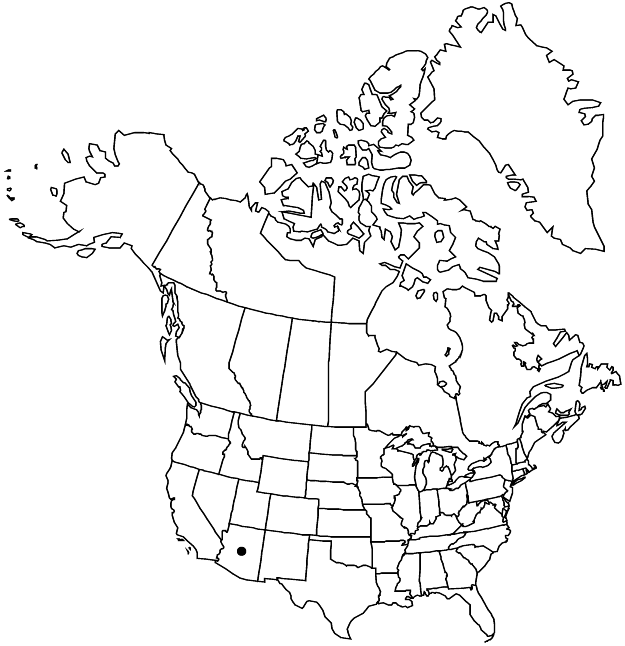Difference between revisions of "Eremogone aberrans"
Novosti Sist. Vyssh. Rast. 10: 139. 1973.
FNA>Volume Importer |
imported>Volume Importer |
||
| (6 intermediate revisions by 2 users not shown) | |||
| Line 8: | Line 8: | ||
}} | }} | ||
|common_names=Mount Dellanbaugh sandwort | |common_names=Mount Dellanbaugh sandwort | ||
| − | |basionyms={{Treatment/ID/ | + | |special_status={{Treatment/ID/Special_status |
| + | |code=E | ||
| + | |label=Endemic | ||
| + | }} | ||
| + | |basionyms={{Treatment/ID/Basionym | ||
|name=Arenaria aberrans | |name=Arenaria aberrans | ||
|authority=M. E. Jones | |authority=M. E. Jones | ||
| + | |rank=species | ||
| + | |publication_title=Contr. W. Bot. | ||
| + | |publication_place=16: 37. 1930 | ||
}} | }} | ||
|synonyms= | |synonyms= | ||
| Line 27: | Line 34: | ||
|elevation=1500-2800 m | |elevation=1500-2800 m | ||
|distribution=Ariz. | |distribution=Ariz. | ||
| − | |discussion=<p>Eremogone aberrans is known only from northern Arizona and resembles a robust form of the more northerly occurring E. aculeata. In Arizona it is often confused with E. fendleri, which has sepals more or less glandular-pubescent whereas E. aberrans has sepals glabrous or with a few glandular hairs at their bases.</p> | + | |discussion=<p><i>Eremogone aberrans</i> is known only from northern Arizona and resembles a robust form of the more northerly occurring <i>E. aculeata</i>. In Arizona it is often confused with <i>E. fendleri</i>, which has sepals more or less glandular-pubescent whereas <i>E. aberrans</i> has sepals glabrous or with a few glandular hairs at their bases.</p> |
|tables= | |tables= | ||
|references= | |references= | ||
| Line 36: | Line 43: | ||
-->{{#Taxon: | -->{{#Taxon: | ||
name=Eremogone aberrans | name=Eremogone aberrans | ||
| − | |||
|authority=(M. E. Jones) Ikonnikov | |authority=(M. E. Jones) Ikonnikov | ||
|rank=species | |rank=species | ||
| Line 50: | Line 56: | ||
|publication title=Novosti Sist. Vyssh. Rast. | |publication title=Novosti Sist. Vyssh. Rast. | ||
|publication year=1973 | |publication year=1973 | ||
| − | |special status= | + | |special status=Endemic |
| − | |source xml=https:// | + | |source xml=https://bitbucket.org/aafc-mbb/fna-data-curation/src/2e0870ddd59836b60bcf96646a41e87ea5a5943a/coarse_grained_fna_xml/V5/V5_115.xml |
|subfamily=Caryophyllaceae subfam. Alsinoideae | |subfamily=Caryophyllaceae subfam. Alsinoideae | ||
|genus=Eremogone | |genus=Eremogone | ||
Latest revision as of 23:08, 5 November 2020
Plants tufted to mat forming, green, not glaucous, with woody base. Stems erect, (3–)10–23 cm, moderately to densely stipitate-glandular. Leaves: basal leaves abundant, persistent; cauline leaves in 5–7 pairs, reduced distally; basal blades spreading to arcuate-spreading, needlelike, 0.8–2 cm × 0.4–0.8 mm, ± rigid, not fleshy, herbaceous, apex spinose, glabrous, not glaucous. Inflorescences: (1–)3–6-flowered, open cymes. Pedicels 6–25 mm, stipitate-glandular. Flowers: sepals 1–3-veined, lateral veins less developed, narrowly elliptic to ovate, 3.5–4 mm, 4.8–5.2 mm in fruit, margins usually broadly winged, scarious, apex broadly acute to obtuse (at least in fruit), glabrous or nearly so; petals yellowish white, spatulate, 5.8–10 mm, 1.3–1.5 times as long as sepals, apex rounded; nectaries as lateral and abaxial rounding of base of filaments opposite sepals, 0.2–0.3 mm. Capsules 7–10 mm, glabrous. Seeds brownish black, suborbicular with hilar notch, 2–2.4 mm, tuberculate; tubercles rounded, elongate.
Phenology: Flowering late spring–summer.
Habitat: Oak and yellow pine forests
Elevation: 1500-2800 m
Discussion
Eremogone aberrans is known only from northern Arizona and resembles a robust form of the more northerly occurring E. aculeata. In Arizona it is often confused with E. fendleri, which has sepals more or less glandular-pubescent whereas E. aberrans has sepals glabrous or with a few glandular hairs at their bases.
Selected References
None.
